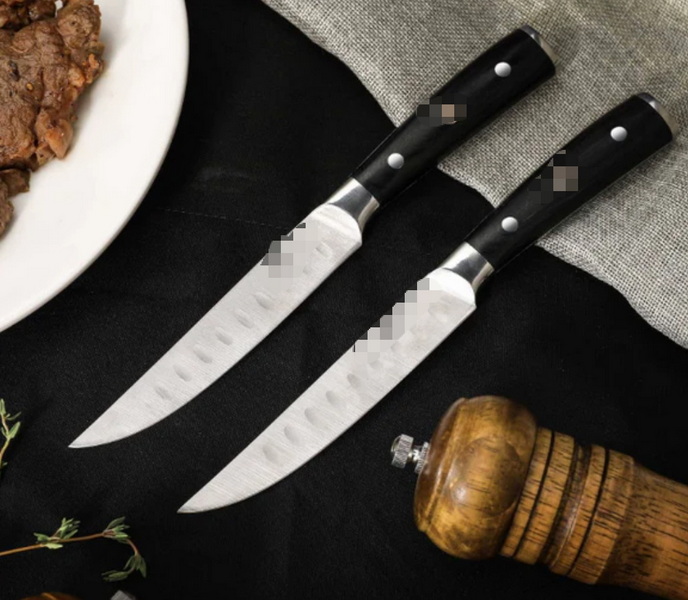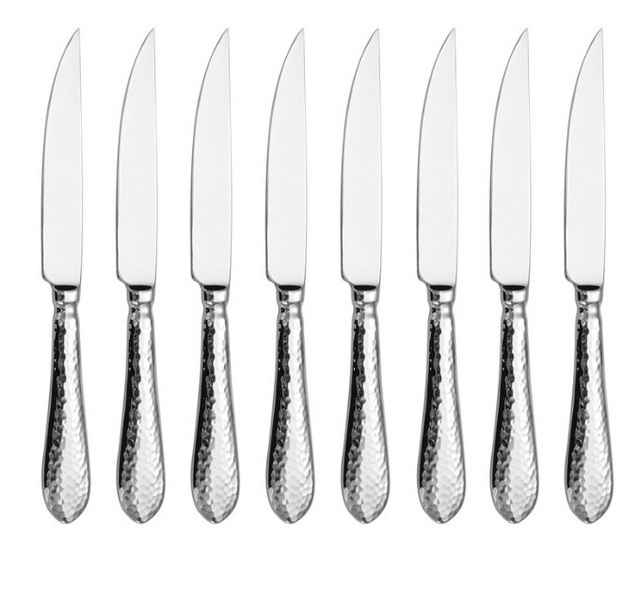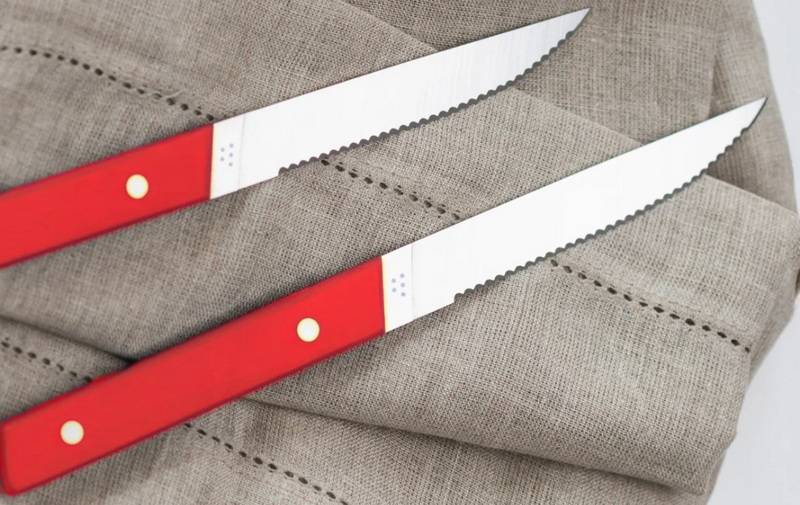- All
- Product Name
- Product Keyword
- Product Model
- Product Summary
- Product Description
- Multi Field Search
Views: 222 Author: Ann Publish Time: 2025-10-29 Origin: Site











Content Menu
● Materials: Core Quality Foundations
>> Blade steels
>> Blade geometry and edge retention
>> Reinforcements and construction
>> Blade shapes
>> Geometry and cutting performance
>> Tang and bolster integration
● Practical guidance: spotting a premium knife
>> Cleaning and drying routines
>> Comparisons: Premium vs Budget
● OEM considerations for international brands
>> Material sourcing and supplier alignment
>> Quality control checkpoints and test protocols
>> Compliance and certifications
>> Careful integration with images and media
● FAQ
>> What blade material offers the best balance of sharpness and corrosion resistance for steak knives?
>> How does edge geometry affect slicing through bone-in steaks?
>> Which handle material provides the best combination of grip and cleaning ease for professional use?
>> What is the ideal blade angle range for a premium steak knife?
>> How should premium steak knives be stored to maintain edge life?
Premium steak knives are more than just sharp blades; they are precision instruments that combine superior materials, meticulous engineering, and deliberate balance to deliver effortless, clean cuts. In professional kitchens and upscale home dining alike, the performance of a steak knife can elevate the entire dining experience. This article delves into what makes a steak knife premium, examining blade materials, geometry, handle ergonomics, and finish. It also discusses how these factors translate into cutting performance under different conditions and how OEM partners can align with global brands' quality standards. For manufacturers, understanding these elements helps in selecting inputs, defining tolerances, and designing for consistent mass production without sacrificing user experience.

High-carbon stainless steels are the bread and butter of premium steak knives. They offer a strong balance between edge retention, corrosion resistance, and ease of maintenance. In premium lines, steels such as VG-10, 440C, and similar high-performance alloys are often combined with controlled carbon content and carefully engineered microstructures to achieve long-lasting sharpness with manageable staining resistance. Some manufacturers explore layered or patterned steels to achieve both aesthetics and performance, including damascus-like laminations that deliver distinctive visuals without compromising edge life when properly heat-treated.
The geometry of the blade determines how effectively the knife glides through meat. A well-designed steak knife typically features a narrow, slightly curved blade that tapers toward the tip. The grind—whether flat, hollow-ground, or a combination—affects cutting feel and maintenance needs. For premium blades, a consistent apex geometry from heel to tip is essential, ensuring predictable bite and reduced tearing. Edge retention benefits from a well-executed hollow grind or micro-bevel strategy that supports light touch-ups between sessions without removing excessive material.
Edge bevels can be single or double. A double-bevel blade is common for Western-style steak knives, delivering symmetrical cutting action suitable for right- and left-handed users. Some high-end models adopt a single-bevel design or asymmetric grind tailored for chefs who prefer a specific cutting approach, often paired with specialized sharpening regimens that maximize performance for professional use.
Handle selection influences grip security, moisture management, and overall balance. Premium options include pakkawood, G-10, micarta, stabilized wood, POM (polyoxymethylene), and reinforced composites. The choice often depends on aesthetic goals, durability under frequent washing, and how the material conducts heat. Ergonomically contoured handles with gentle palm swell, a comfortable finger groove, and a non-slip texture help maintain control during long prep sessions or extended service. Some OEM programs integrate color-matched or logo-embossed handles to reinforce brand identity.
Full tang construction with a robust bolster is a hallmark of premium steak knives, offering durability, balance, and a seamless feel in the hand. Full tang blades extend through the handle, distributing weight and reducing breakage risk under heavy use. Bolsters contribute to balance and provide a natural transition from blade to handle, while also protecting the hand during close work. In certain designs, hidden tangs or modern mechanical fasteners are used, but the best-performing premium knives prioritize strong, clean joints with tight tolerances.
Surface finish affects aesthetics and performance. Bead-blasted finishes reveal a matte texture that can mask micro-scratches and reduce glare, while mirror-polished surfaces highlight craftsmanship and emphasize edge alignment. Satin finishes offer a balanced look with practical maintenance advantages. For premium models, finish consistency across the entire blade is critical, as any waviness or blemish can hint at manufacturing variance and impact perceived quality.
Steak knife blades range from narrow utility profiles to more substantial chef-like blades. The most common form emphasizes a slender profile suitable for clean slicing through muscle fibers without tearing. Some premium knives incorporate a slightly curved belly for a smoother draw cut. The tip geometry is important for precise control when navigating around bones and cartilage, and a well-balanced design reduces hand fatigue during repetitive cuts.
Edge angle plays a decisive role in sharpness and longevity. A typical premium steak knife uses a bevel angle around 15–20 degrees per side, allowing a fine edge that remains robust under normal kitchen loads. Grind type—bevel, flat, or hollow—affects how the blade slices through meat and how easily it returns to edge during maintenance. Precision in grind consistency across the blade translates to predictable performance from tip to heel.
Balance is the tactile sense of control during cutting. It is largely determined by the relationship between blade weight, handle weight, and the center of gravity. A well-balanced steak knife feels lighter in the hand and requires less wrist effort to maintain stable slices. Manufacturers often test balance by pinching near the blade tang and by performing simulated cutting tasks to ensure the center of gravity aligns with the user's natural hand position. For OEM programs, achieving consistent balance across batches requires strict process controls and quality assurance at the grinding, tempering, and assembly stages.
A durable joint between blade and handle is essential for long-term reliability. Full tang construction paired with a substantial bolster fosters a seamless feel and reduces radial flex that can cause misalignment or fatigue. The bolster also acts as a hand guard during close cutting operations, enhancing safety in high-pressure kitchen environments. For premium lines, the joint geometry is carefully machined to minimize gaps and maximize tactile feedback—an indicator of meticulous craftsmanship.
- Tight tolerances and consistent blade geometry across the entire length.
- Balanced weight distribution with a natural feel in the hand.
- Ergonomically contoured handle with reliable non-slip grip and clean transition to the blade.
- High-grade blade material with predictable edge retention and corrosion resistance.
- Finishes that are uniform without tool marks or waviness and that resist showing fingerprints or dulling.
Damascus pattern does not automatically guarantee superior steel quality or edge performance. The pattern is a visual feature that can accompany high-quality steel, but the base metal and heat treatment determine real performance. Likewise, hollow handles or excessive decorative elements do not inherently improve balance or durability. The premium factor lies in material choice, construction integrity, and manufacturing accuracy.

- Rinse blades promptly after use to remove salt and acidic residues.
- Dry with a soft cloth to prevent water spots and corrosion on exposed metals.
- Avoid leaving knives soaking in water or damp containers for extended periods.
- Use a guided sharpening system or a professional sharpening service to maintain consistent edge angles.
- For double-bevel blades, sharpen evenly on both sides to preserve symmetry.
- Lightweight touch-ups with fine-grit whetstones or polishing pastes help maintain a razor edge between major sharpenings.
- Store premium steak knives in a dedicated sheath, knife block, or magnetic strip designed to hold them securely without nicking blades or dulling edges.
- Ensure storage solutions keep blades dry and free from moisture buildup.
- Material quality: Premium blades use higher-grade steels with better carbide structures, resulting in longer edge life and lower micro-chipping risk.
- Ergonomics: Premium handles are shaped for comfort and control, and the blade-to-handle transition is engineered for balance and safety.
- Precision: Premium knives exhibit tighter tolerances in blade height, edge straightness, and grind consistency, which translates to more uniform cuts and easier maintenance.
- Establish clear material specifications, including steel grade, heat treatment, and surface finish requirements.
- Audit suppliers for process controls, consistency, and traceability of raw materials.
- Implement standardized testing protocols to validate hardness, edge retention, and corrosion resistance.
- Pre-assembly inspections on each blade for straightness, edge integrity, and grind consistency.
- Post-assembly inspections for balance, tang fit, and handle alignment.
- Random sampling of finished knives for performance testing, including cut tests on standardized materials.
- Logo placement, etching, and engraving on blades or handles.
- Packaging customization with branded inserts and anti-counterfeit features.
- Variations in handle materials, textures, and color schemes to meet regional preferences.
- Ensure food-contact material compliance and safety documentation.
- Obtain relevant certifications or verifications (e.g., testing standards for kitchen tools) as required by target markets.
- Maintain documentation for traceability and quality audits.
- In the final published article, embed high-resolution images showing blade materials, handle textures, and balance demonstrations.
- Include video demonstrations illustrating cutting performance, edge stability, and sharpening techniques to reinforce the material and design concepts.
Premium steak knives represent a synthesis of superior materials, thoughtful design, and precise balance. By selecting high-grade blade steels, harmonizing blade geometry with ergonomic handles, and achieving a balanced feel that reduces fatigue, a steak knife from a reputable OEM partner can deliver consistent, high-quality performance across professional kitchens and home settings. The OEM pathway emphasizes robust supplier relationships, strict process controls, and customization options that help brands differentiate their offerings while maintaining reliable manufacturing performance. With these elements in place, brands can confidently position premium steak knives in global markets, delivering measurable value to end users and strong competitive advantages for partners.

Steels engineered for high hardness, good toughness, and corrosion resistance, such as high-carbon stainless steels, provide an excellent balance. These materials support a razor edge while resisting staining under typical kitchen conditions. Specific alloy choices and heat treatment determine the final performance profile.
A well-designed edge geometry promotes clean, controlled cuts while minimizing tearing. A narrow, precisely ground blade with a comfortable tang and bolster allows for controlled pressure application around bone areas. Regular maintenance helps preserve this performance over time.
Materials like POM, G-10, and stabilized woods offer strong grip security and durability under frequent washing. Selecting a handle with ergonomic shaping and non-slip textures enhances control, while choosing water-resistant or stabilized materials reduces warping and swelling.
An edge angle around 15–20 degrees per side is common for premium steak knives, balancing sharpness with edge life. Precision in grinding and consistent angles across the blade are critical for predictable performance.
Store them in a dedicated knife block, sheath, or magnetic strip that keeps blades separate and protected. Ensure moisture-free storage and avoid overcrowding to prevent nicks and dulling. Regular maintenance and dry storage help preserve the edge longer.
The Ultimate Professional Knives for Halal Butchery in Middle Eastern Kitchens
Chef Knife Size Guide: Choosing Between 6″, 8″, 10″, And 12″
Custom Knife Handles: How To Design A Chef Knife That Fits Your Hand Perfectly
Chef Knife Surface Treatments Guide: From Polished Migaki To Damascus Patterns
Inside Our Professional Knife Sample Room: Quality You Can See
Universal Knife Block Buying Guide: Modern Acrylic & ABS Knife Holders for Professional Kitchens
Universal Knife Block: The Complete Guide To Modern, Hygienic Knife Storage
The Complete Guide To Red Handle Knife Sets: Style Meets Functionality in The Kitchen
Professional Knives for Halal Butchery And Middle Eastern Cuisine